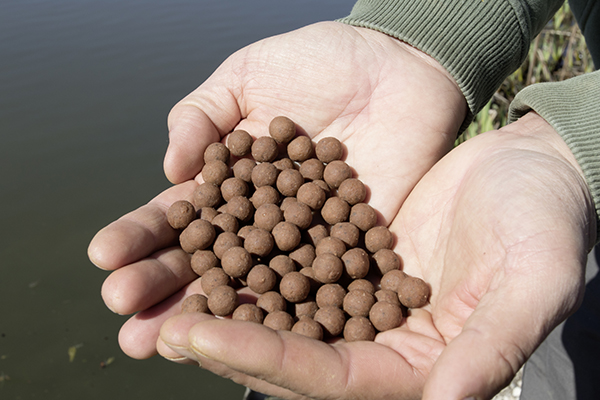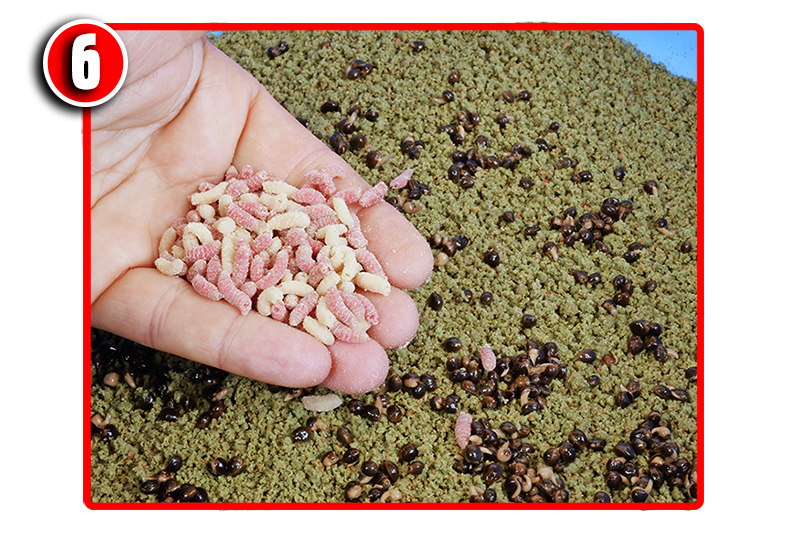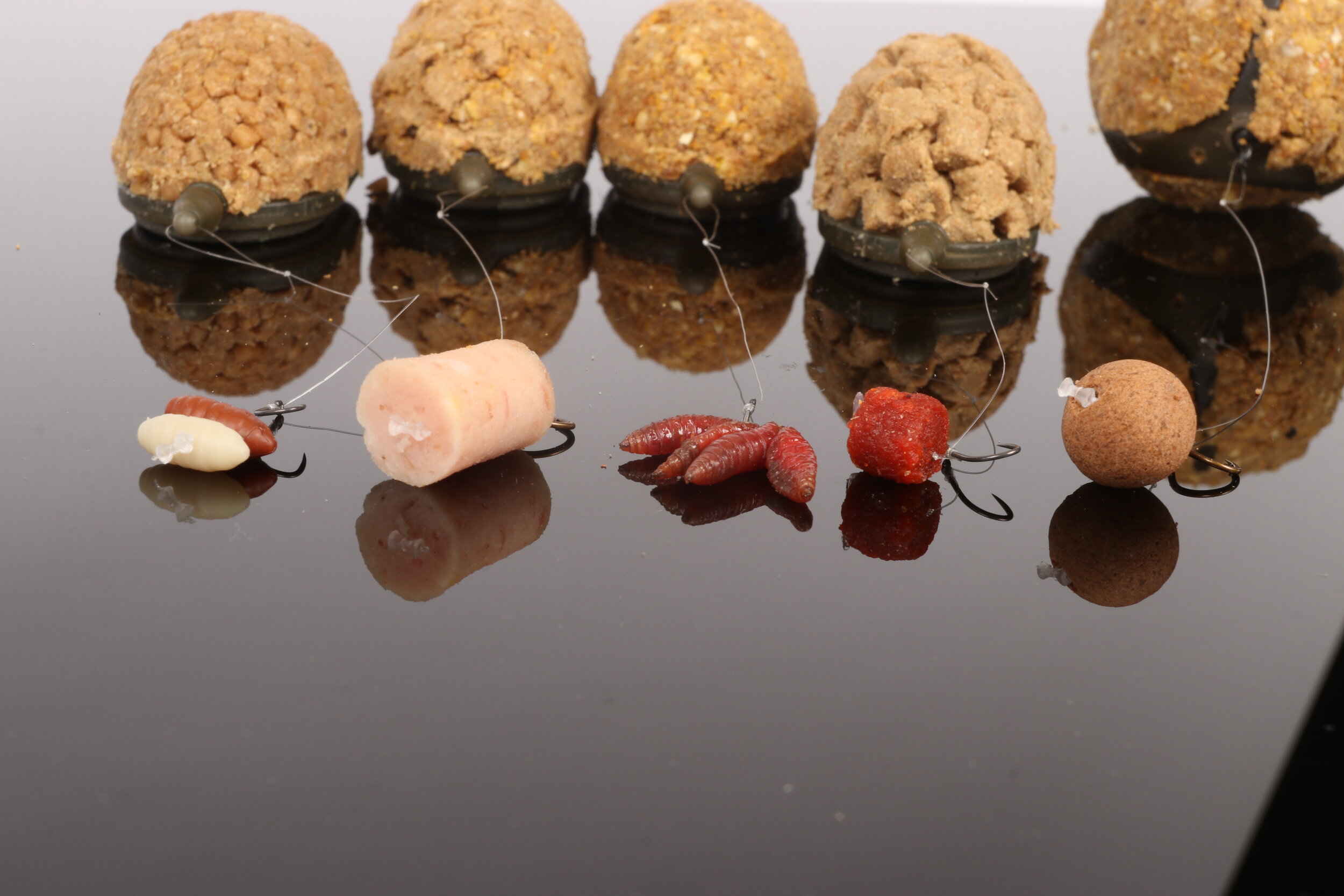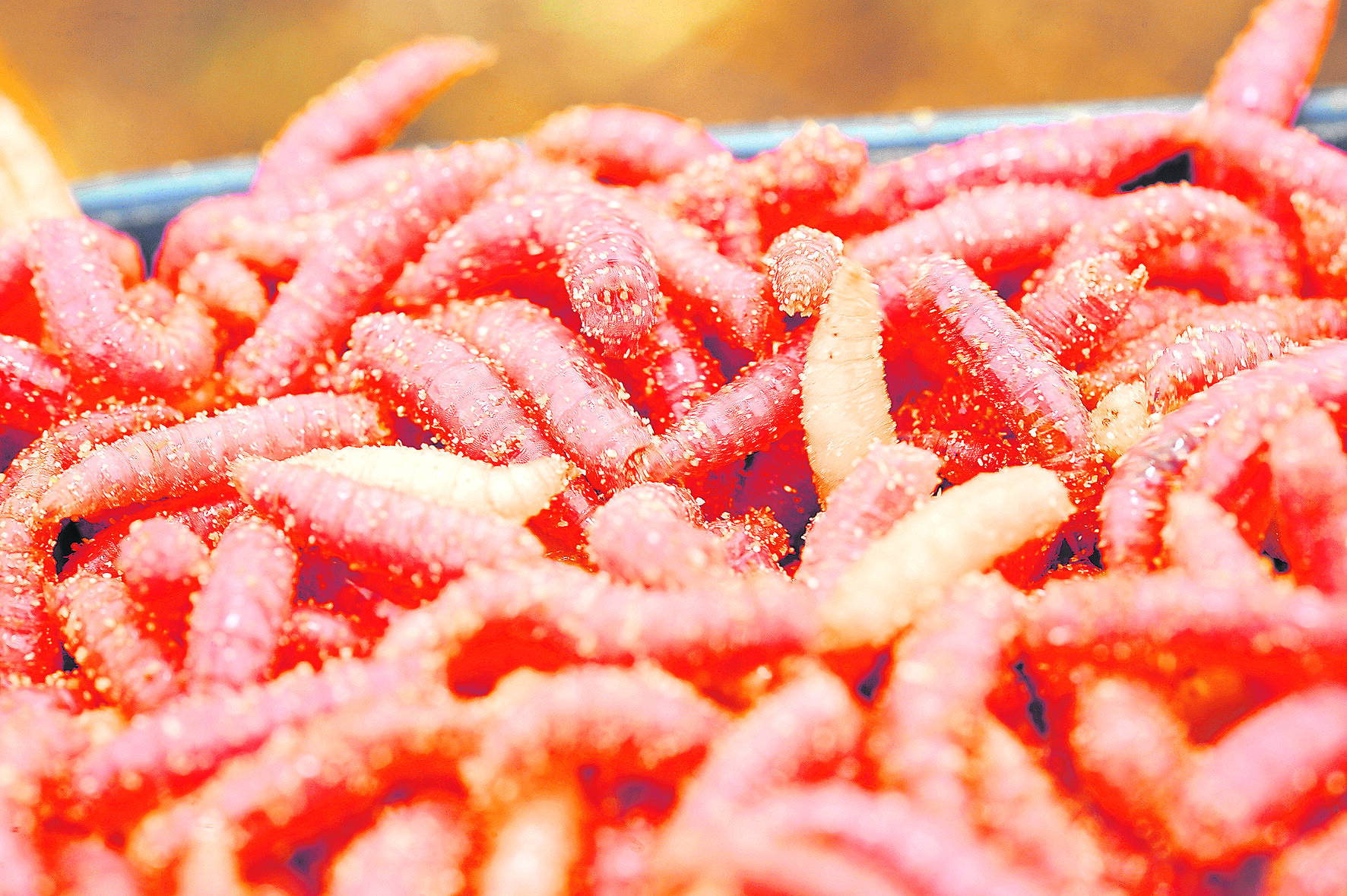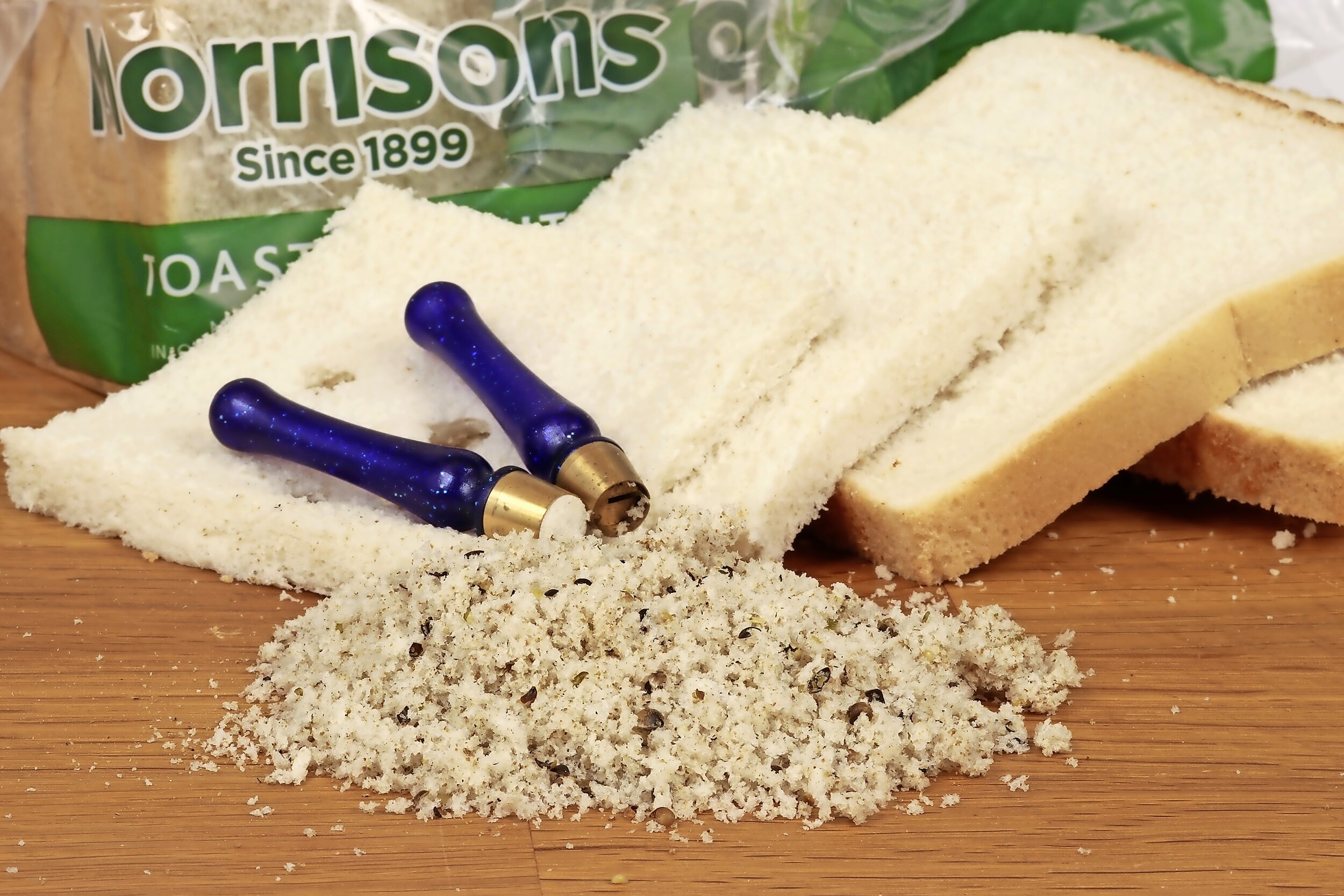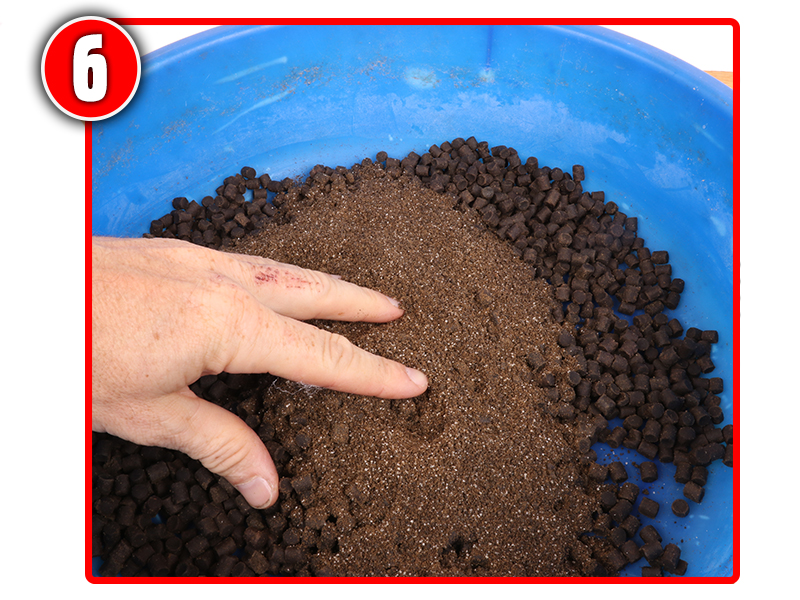The best bream fishing bait mix
Two-time Drennan Cup winner Dai Gribble reveals what his favourite bream fishing spod mix is. Take a look at the four steps below and try it out for yourself next time you're out on the bank bream fishing.
1) My feed is made up of a mixture of Sonubaits fishmeal and bread-based groundbaits. I will use Supercrush Bream Feeder as a base for the mix but will darken this off with Super Crumb Black Bream. You can make the mix even stickier by adding Super Crumb River to it, and this helps when you’re making long casts on the Method feeder.
2) The groundbaits are blended together first and then are mixed up with lots – up to a pint – of liquid molasses. Molasses is quite dense and very soluble, and a trail of it will leak off the groundbait in the undertow, pulling bream from a long distance.
3) The crumb is supplemented by a mix of Pro Feed and S-Pellet Feed Pellets in 2mm and 4mm sizes – great for keeping fish in the swim for longer – plus a couple of tins of F1 sweetcorn.
4) I also add a small number of the boilies that I use for hookbaits. The critical thing is not to introduce too many of the high-attract baits as free offerings. You want enough for the bream to get a taste for them and hunt them out, but not so many that it reduces the chances of them taking your hookbait.
Generally, I add no more than about 30 boilies, whilst using up to five kilograms of groundbait and pellets.
Dr Paul Garner's 10-minute make | Green method groundbait
You can use a cage feeder loaded with a mixture of groundbait and casters, but often a more effective tactic is to use the same baits moulded around a Method feeder. The feeder is tangle-proof, and its low profile unobtrusive when fished with 4ins hooklengths.
Dynamite’s Swim Stim Green is my groundbait of choice, and to two pints of groundbait I will add a pint of krill powder. This combo has been very effective everywhere I have used it and is very easy to mix to the right consistency for the feeder. There is no need to go overboard with the casters. A pint is ample, and just as when maggot fishing, I will bulk this out with a similar amount of hemp.
Add one pint of krill powder to two pints (one bag) of Swim Stim Green groundbait and mix well.
Mix a tablespoonful of sweetcorn extract to each pint of lake water used to mix up your groundbait.
Mix thoroughly and let it stand for a few minutes to allow the water to be fully absorbed.
Riddle the groundbait to remove any lumps and to ensure it is blended thoroughly.
Add a small amount of hemp – not too much or it will cause the groundbait to break up.
Add a similar amount of dead maggots or casters to the groundbait mix.
How to make a high-attract stick
PVA can be used with a wide range of different dry additives, and even liquids if they are ‘PVA-friendly’. This is one of my favourite stick mixes, but don’t be afraid to include your own favourite ingredients.
1) Grind up a handful of boilies into a fine powder. You can then either use these neat or mix them 50-50 with breadcrumbs.
2) Add your powdered additives to the boilie crumb. Make sure you mix well to evenly distribute the powerful attractors.
3) Add a few drops of boilie dip and mix well. The liquids will coat the boilie crumb and give an instant hit of flavour into the water.
4) Put about a tablespoonful of the boilie crumb into a fine PVA stick and compress it well down, using a plunger if possible.
5) Tie off the end of the stick – the finished PVA should be about 20mm in length, just enough for a single mouthful.
6) Thread the stick on to your hooklength and pull the hookpoint into it. A contrasting colour of wafter hookbait will really stand out.
How to use hemp correctly when fishing for roach
Hemp is still a bait that so many anglers steer clear of when it comes to fishing for roach.
The seeds are fiddly to get on the hook, and when the angler finally gets a bait in the water he’s unable to catch anything.
That’s far from the truth. It may not every day that sees hemp work, but when you’ve got a swim producing a fish a cast on maggots and casters, there’s no reason why changing to hemp should lead to a halt in bites – provided of course, you’ve been feeding hemp from the word go.
This week’s coach is a real blast from the past – Pete Jayes. The Leicester angler has enjoyed a glittering career stretching back to his days with Ivan Marks and the Likely Lads.
Here are his top tips for catching big roach on ‘the seed’ this autumn…
Present it correctly
“Whereas maggots and casters are best fished overdepth, I think hemp works brilliantly when presented just off bottom and run over just a few feet of a river swim as opposed to way down the peg.
“I try and get the grain on the hook to act in the same way as the loosefeed underwater. Hemp on the riverbed won’t move with the flow, due to its weight, so why should the hookbait?
“I think roach line themselves up in the flow waiting for the hemp to arrive – if the bait acts suspiciously they won’t look at it.”
When tares work
“I never fish hemp without having a few tares with me because they are a brilliant hookbait that picks out the bigger roach in the swim. They are a much bigger bait than a grain of hemp, and they’re also easier to get on the hook.
“Once the roach are lined up on hemp it’s time to try a tare on the hook. I prepare my own, but to make them even softer I will freeze a few and then defrost them before use.”
Different rigs
“I always have two pole rigs on the go for hemp work because no two days are ever the same.
“You have to try different depths and shotting patterns to make the hookbait behave as much like the loosefeed as you can.
“I’ll fish a 0.4g bodied float plus a much lighter 4x14 slender Preston Innovations Chianti model. Both are shotted using nothing larger than No10 shot, as this allows me to move them up and down the line for different presentations. You can’t do that with heavier shots.”
feeding
“Varying how many grains of hemp you loosefeed is the road to ruin. I reckon roach like a constant stream going in – the more regular the feeding is, the better the fishing will be, so I fire in around 12 grains every run through and never alter this.
“Should I think that a change needs to happen, this comes by altering the shotting on the rig rather than how much I am feeding.”
Light lines, small hooks
“In keeping with the delicate presentation that I am trying to achieve, my lines and hooks have just as much finesse.
“A hook that’s too big and a line that’s too thick will make the hookbait act unnaturally underwater, so typically I fish 0.10mm mainline to an 0.08mm hooklink.
“Your hooks should be very light as well, but they need to have a wide gape to help the hemp sit properly.
“For me the best out there is a Kamasan B511 in a size 20 or 18.”
Best winter baits for fishing
For many anglers, now is the time when sport is at its very best.
Most species are feeding up hard to pack on weight for winter, and a well-presented bait will see plenty of action. We start with 15 autumn-gold nuggets of advice from big-fish expert Dr Paul Garner...
1) Try dead maggots or worms
Two baits stand out for crucians right now – two dead maggots fished over a light scattering of groundbait can work wonders, but a close second comes half a dendrobaena, hooked at the broken end to leak off the juices.
2) It's a wrap for barbel
When boilie fishing for barbel I rarely cast out without wrapping some matching paste around the hookbait. This can work wonders if the fish are proving finicky. A useful trick is to use a 12mm hookbait wrapped in paste, but feed 15mm baits.
3) Gob-stoppers trick wily carp
With everyone using boilies of 18mm or less, you can fool wary carp by going large and 24mm or even larger baits. Scale up your hook size ti match the big bait.
4) Enjoy traditional roach sport
Many of our larger rivers are teeming with roach at the moment. One of the nicest ways of catching them is to use loosefed hemp with prepared tares on the hook.
Start with a pinch of hemp every cast and fish a matching grain on the hook. Once you start getting bites regularly swap to a tare and your reward should be a bigger stamp of fish.
5) Big bream are feeding up
A windy autumn can see shoals of big bream feeding hard. I lay out a big spread of bait to hold the shoal.
Into the mix go a tin of sweetcorn, two pints of dead maggots, some mini-boilies and soaked flaked maize. Bind the lot together into balls with a mix of brown crumb and layers mash.
6) Mid water baits for Rudd
For consistent autumn rudd sport try using a 10mm pop-up or a lump of breadflake on a 12ins-36ins hooklength, so the bait is presented in midwater
7) Stock up now
Get your deadbaits stocks sorted now to ensure a ready supply for winter. Big smelts are always in short supply, so order early.
Split bulk baits into small airtight bags and freeze down. Dip each bait in cold water before freezing, as this will stop them getting ‘freezer burn’.
8) swap to a cone
A pellet cone is a much neater presentation than the Method feeder, and really comes into its own in the coming weeks, especially on venues where the carp have seen it all over the summer months. Vary the size of the cone to control the amount of feed you introduce.
9) The subtle snowman
Very often carp never actually get the hook into their mouths, just the boilie. This can be even worse with a snowman presentation. So try my ‘subtle snowman’ (below), made by cutting a 15mm boilie and a 15mm pop-up down to form a single back-to-back bait.
10) Feed, feed, feed for chub
The key to unlocking brilliant autumn chub sport comes down to how you feed. The simple solution is to drip-feed as regularly as you can. This could be as little as three pellets or maggots every few seconds.
11) Fry-feeding perch
Now is the time to target perch, which predate heavily on small fish which are in the margins over the next few weeks. Use small lures for this – a selection of bright green and more natural hues.
12) Go soft for roach
On many fisheries roach have developed a love of pellets. This can cause problems with fast, hard-to-hit bites. This phenomenon is simply down to both baits being hard, and to combat this try using soft hooker pellets – I find 4mm baits are best.
13) Flavoured meat in floods
Try to coincide barbel trips with the river falling back after a flood. If you have to fish as the river rises, stick to a straight lead and a large smelly bait such as Crab & Krill flavoured luncheon meat.
14) Slug it out for chub
Dew-laden mornings will see hundreds of slugs and snails attacking your garden plants. Rather than chuck them over the neighbour’s fence, why not collect them for an afternoon’s chub fishing?
15) Try red corn down the edge
A float down the edge works for carp that feed in the margins at dusk.
Add a few drops of boilie dye to a tub of corn the day before fishing and you will be left with a lovely dark-red bait that is eaten with enthusiasm.
Best bait to catch bream on
When it comes to trying to bag up on bream, it's difficult to know what the best bait to use is. Wonder no more as we have gone to bait expert Dr Paul Garner to find out what the best bait is when it comes to bream fishing.
On a natural river or gravel pit, 100lb of fish averaging 4lb is my benchmark for a seriously good session. My tactics are nothing revolutionary, but I do make a few tweaks that make a significant difference to my results.
The centre of attraction
Bream are big fish that make a lot of wake as they move around – this can send groundbait and pellets in all directions. Rarely will a Method feeder deposit a neat pile of feed next to the hookbait, except if a fish cruises in and picks it up immediately. How far the bait spreads out and how long this takes depends on the number of bream in the swim.
To combat this I pack some of the bait tightly on to the feeder and either leave the hookbait hanging free, or load it right on the outside of the feeder. Try it – your catches are sure to improve.
Hookbait choice
Boilies and pellets seem to be becoming just as high up the menu for bream as they are for carp, but these baits are not always my immediate choice. Sweetcorn is another very effective bream bait – and underused at that.
With care, the classic combination of corn and a dendrobaena worm can be effective, but take care if you are fishing at range, as the shock of the feeder hitting the water can dislodge even these tough worms.
A bunch of dead maggots is another useful alternative. I prefer red, as they stand out less well, making them less vulnerable to the attentions of silver fish.
Four dead maggots on a size 12 hook is a formidable bream bait, especially when the water is clearer than I would like.
I keep pellet hookbaits relatively small for bream. An 8mm pellet is about right, even for big slabs. Only when I’m targeting double-figure fish will I go bigger than this, as I feel I miss fewer bites on the smaller baits.
Boilies follow a similar rule. An 8mm or 10mm bait is ideal for bream, preferably a wafter, as I am sure that I hook more fish on these semi-buoyant baits.
The flavour of the boilie is almost irrelevant, as I will be boosting it anyway and this will mask the locked-in smell.
Bream feeds
Pellets revolutionised bream fishing and today it would be difficult to think about not using these fishmeal-based baits.
Within reason, the more oily the pellets, the more bream will be attracted to them. Halibuts are perfect, but expensive to use on their own, so if I want to prebait, for example, I will use them in combination with cheaper baits, such as corn and flaked maize.
A spod is the bream angler’s best friend when fishing at range. If you clip up at the same distance as the rods that are actually fishing it’s easy to hit the spot every time, giving you a precisely controlled bed of bait. A spread of bait can be achieved in just 10 minutes, and it’s far more accurate than using a catapult. A bag of pellets and two tins of corn will be plenty for a day session or overnighter, as this will be topped up with bait from around the feeder.
Plain brown crumb is the ideal base for groundbaits, especially if you combine it with liquid molasses to produce a classic bream combination. I like to use a 50-50 mix of crumb and a fishmeal-based groundbait such as Sensas Crazy Bait Gold, Dynamite Marine, or Sonubaits Supercrush.
Sticky sweet feed pellets
Combining savoury fishmeals with sickly-sweet liquids might seem strange, but bream love the unlikely mix. I guess that the sweetness takes the edge off the bitter taste that many pellets have, especially those that are high in oil. This combination creates a potent feed pellet, ideal for spodding out or using on a Method feeder.
Use a coffee grinder to reduce a couple of handfuls of 6mm feed pellets to a coarse powder.
Add two tablespoonfuls of demerara sugar to the pellet powder and mix well.
Dissolve two tablespoonfuls of liquid molasses in a pint of lukewarm water.
Add a teaspoonful of liquid betaine to the water. Bream love the stuff!
Soak a bag of 6mm feed pellets in the liquid for six minutes, then pour off any excess water.
Add the powder mix to the damp pellets and shake to evenly coat the pellets in the powder.
How to make a great bream spod mix
Dynamite Baits specialist Paul Elt has got a great bream spod mix recipe that will pull the slabs into your swim and is a key part of you trying to land a specimen bream this season. Follow our simple step by step guide below to create this irresistible spod mix.
Mix 1kg each of Dynamite 6mm Halibut pellets and 4mm Halibuts.
Add a bag of CSL Spod Mix to the 2kg of pellets.
Two or three tins of corn give great visual appeal to the mix.
Half a jar of Frenzied Hemp goes into the mix, plus all the juice.
Finish off with a good glug of CSL Liquid Carp Food.
Dr Paul Garner's 10- minute make | Pellet mash
Pellet mash is best prepared the night before fishing, and it takes only a few minutes’ work before it is left to soak until morning. Alternatively, speed up the process if you are in a hurry. A couple of kilos of bait will be plenty for a day session.
Soak 6mm halibut pellets in cold water for 10 minutes. You can speed up the process by using warm water.
Pour off the water and add a teaspoonful of hemp oil to the pellet mix. Shake well to distribute the oil evenly.
Once the water is absorbed, mix them up. Those at the bottom turn to mush, those at the top are soft, but still intact.
Two handfuls of dry Method Mix groundbait will soak up any excess moisture and help bind the pellets together.
Dr Paul Garner's 10-minute make | Sweetened pellets and bulk groundbait
The combination of sweet additives and fishmeal-based baits has revolutionised bream fishing, and both these can be incorporated into all your baits.
A couple of days before a bream session, put your pellets into a bait bucket and add two tablespoonfuls of molasses to each kilo of pellets. The sweet, sticky liquid will infuse the pellets, boosting their appeal.
Make up a 50:50 mix of brown crumb and fishmeal Method mix. Add a teaspoonful of salt per kilo.
Mix using water with two tablespoonfuls of molasses added to each pint of liquid.
Mix large amounts of groundbait in a sizeable bucket. A groundbait whisk speeds up the process.
Add boilie flake, corn and pellets. Chopped worm and dead maggots are useful additions too. The baits added to the mix will alter the consistency, so add them only when you are ready to introduce your feed.
A bait combination for every species with bait expert Dr Paul Garner
The bait you load on to your feeder can make a massive difference to the fish you catch. Here are some of my favourite combinations...
The Method is super-effective for big greedy carp. Recast regularly at the start of a session to lay down a bed of feed, and use a groundbait containing flaked maize, small pellets and other morsels to keep carp grubbing around. Top this off with a shaved 15mm wafter boilie on the hair.
Commercial carp respond well to feed pellets. The bulk of my feed will be 4mm pellets, but to stop the carp getting fixated on these I’ll add a handful of 6mm pellets to the mix. Start with an 8mm banded pellet but be prepared to switch to a larger or smaller bait
Fishmeal pellets with a Method feeder are deadly for bream. I combine sweet and fishmeal elements in all my bream mixes. Sticky pellets, softened with molasses-flavoured water, are a great starting point for bream at range, with pellet, mini-boilie and hair-rigged worm hookbaits.
My light, high-attract groundbait is low in food value – Dynamite Swim Stim Green with added Krill or crayfish powder as a stimulant. On the hook use corn for tench, while for crucians give a 6mm soft pellet, a rubber caster or a bunch of dead maggots a try.
On lakes that get lots of carp bait the roach and rudd will see a Method load as an easy meal. With a 10mm boilie on the hair, load the feeder with a 50-50 mix of dark fishmeal goundbait and brown crumb. For rudd I swap a boilie hookbait for a pop-up fished 4ins-6ins off the deck.
Dr Paul Garner's 10-minute make | The chopped worm method
The Method feeder is a great way of catching tench – the combination of groundbait and chopped worm is hard to beat, especially with my secret ingredient, Krill powder.
Into a bait bowl add three parts of Dynamite Baits’ Swim Stim Green groundbait to one part Krill powder. Mix it up dry to start with.
Wet the groundbait slowly until it will stick well to a flat Method feeder. Leave to stand for a while until the water is fully absorbed.
Finely chop a handful of dendrobaena worms so that they are reduced to a fine mush, then mix the worms into the groundbait.
Use a Quick Stop on a size 12 hair rig to hold a worm in place. The stop can be pushed through the worm, but will then hold it securely.
Alternatively, try swapping the worm for an artificial caster on the hair. This will often produce extra bonus tench.
Six easy steps for using corn
There are few cheaper and more effective baits for commercial fishery carp at this time of year than sweetcorn. A large tin from the supermarket will set you back less than a pound, but it can provide enough bait to last the best part of a session. Corn is highly effective for a number of reasons, and high on that list is its bright colour and softness, especially when compared to a 6mm pellet or a cube of meat.
The colour makes corn stand out when fished on its own or over a bed of another feed, while its softness is much loved by all fish. It’s also not particularly filling, as a grain of corn boasts a high water content so carp can trough away for hours without getting full. It’s also brilliant for other species, with bream, tench and even quality roach all loving the yellow stuff!
Try sweetcorn on different colours
In its natural form, corn is bright yellow, and that’s perhaps the main reason for its effectiveness. Even in coloured water, fish can easily pick out a grain, and if the lake is slightly clear, this ‘high-viz’ quality comes even more to the fore. However, you can buy corn in different colours and flavours, and on some waters red corn will outfish yellow. If you’re not sure which colour to use, arm yourself with a variety and keep changing on every cast until you catch – even green corn can have its day!
Big hooks
Compared to a maggot or a pellet, corn is a big bait, so you need to match the size of the hook accordingly. On the strike, the hook will pull through a soft piece of corn but you’ll need to be able to mount the bait properly so it stays on during the cast. Pick a hook with a wide gape as this will allow the bait to sit comfortably on the bend, while leaving a decent amount of the hookpoint on show. This will aid hooking when the float goes under. In terms of hook size, a 14 or 16 will be just about perfect.
Choose the right floats
Corn is quite a heavy bait, so this means you have to think big when it comes to floats, especially when fishing in open water. If your float is too light then the presentation will be unbalanced, and the fish will sense this. On the pole, pick a float with quite a big body, such as a rugby ball or diamond shaped one of 0.5g to 0.7g, dependent on the depth. When fishing the margins this can be smaller, but certainly no finer than a 4x12 pattern. Shot this with a bulk and one dropper shot and set the rig so that the corn is just resting on the bottom.
Combine it with other baits
Fished on its own, corn is deadly, but it can be improved by feeding it with other baits. Hemp is brilliant when fed to create a bed on the bottom, over which corn hookbaits are fished to really stand out. Cubed 6mm meat is another winner at this time of year, mixed 50/50 with corn as feed. You can also pop a few grains into chopped worm and caster feed and this will give you the option of changing from a worm hookbait to a piece of corn if small fish are a problem.
Hooking Corn
There is a right way to hook corn, and although you can simply nick the hook through the side, it will eventually work loose and be hanging on by a thread. The best way to mount a grain of corn is to pierce it through the rounded end and work the hook down the grain so it comes out of the flattened bottom end. This ensures that all of the shank and most of the bend is inside the grain, leaving just the hookpoint on show. Using double corn also adopts the same principle.
Give it a go in shallow water
Should you be faced with fishing the far side of a snake lake or a shallow margin, corn can be transformed into a superb shallow-water feed. All it needs is a food blender to whizz the corn about for a few seconds to chop it into smaller pieces. When fed, it’ll create a lingering cloud, while the larger pieces will sink that bit slower. You can even go the whole hog and blend the corn into a sloppy soup that’ll put a bigger cloud into the swim. This works particularly well if the fish are feeding off the bottom.




